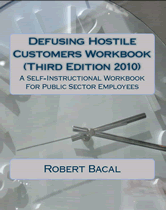
Understanding The Cycle of Change, And How People React To It
Robert Bacal is a noted author, keynote speaker, and management consultant. You can view his bestselling books by going to the Bacal book listings here. In this article Robert outlines some of the basic elements and principles needed by managers, executives, and supervisors, in understanding how people react to change, and managing the workplace change process.
Managers often make the mistake of assuming that once a change is started, that employees will see that it is going to take place, and get on side. This is rarely the case. Because change causes fear, a sense of loss of the familiar, etc., it takes some time for employees to a) understand the meaning of the change and b) commit to the change in a meaningful way. It is important to understand that people tend to go through stages in their attempts to cope with change. Understanding that there are normal progressions helps change leaders avoid under-managing change or over-reacting to resistance.
As we go through the stages, you will probably find many similarities with the process a person goes through with the loss of a loved one.
Stage I: Denial
An early strategy that people use to cope with change is to deny that it is happening, or to deny that it will continue or last. Common responses during this stage are:
"I've heard these things before. Remember last year they announced the new customer initiative? Nothing ever happened, and this will pass."
"It's just another hair-brained idea from the top."
"I bet this will be like everything else. The head honcho will be real gung-ho but in about six months everything will be back to normal. You'll see."
"I'll believe it when I see it."
People in the denial stage are trying to avoid dealing with the fear and uncertainty of prospective change. They are hoping they won't have to adapt.
The denial stage is difficult because it is hard to involve people in planning for the future, when they will not acknowledge that the future is going to be any different than the present.
People tend to move out of the denial stage when they see solid, tangible indicators that things ARE different. Even with these indicators some people can remain in denial for some time.
Stage II: Anger & Resistance
When people can no longer deny that something is or has happened, they tend to move into a state of anger, accompanied by covert and/or over resistance. This stage is the most critical with respect to the success of the change implementation. Leadership is needed to help work through the anger, and to move people to the next stage. If leadership is poor, the anger at this stage may last indefinitely, perhaps much longer than even the memory of the change itself.
People in this stage tend to say things like:
"Who do they think they are? Jerking us around"
"Why are they picking on us?"
"What's so damned bad about the way things are?
"How could [you] the boss allow this to happen?
Actually people say far stronger things, but we need to be polite.
Stage III: Exploration & Acceptance
This is the stage where people begin to get over the hump. They have stopped denying, and while they may be somewhat angry, the anger has moved out of the spotlight. They have a better understanding of the meaning of the change and are more willing to explore further, and to accept the change. They act more open-mindedly, and are now more interested in planning around the change and being participants in the process.
People in this stage say things like:
"Well, I guess we have to make the best of it."
"Maybe we can get through this."
"We need to get on with business."
Stage IV: Commitment
This is the payoff stage, where people commit to the change, and are willing to work towards making it succeed. They know it is a reality, and at this point people have adapted sufficiently to make it work. While some changes will never get endorsement from employees (downsizing, for example) employees at this stage will commit to making the organization effective within the constraints that have resulted from the change.
Concluding Points
Let's conclude with some key points:
1) The change process takes a considerable amount of time to stabilize and to work. Don't undermanage by assuming it will "work itself out" and don't over-react when faced with reasonable resistance.
2) Worry if there is no resistance. If the change is significant it means that people are hiding their reactions. Eventually the reactions that are not dealt with will fester and can destroy the organization. Likewise with anger.





